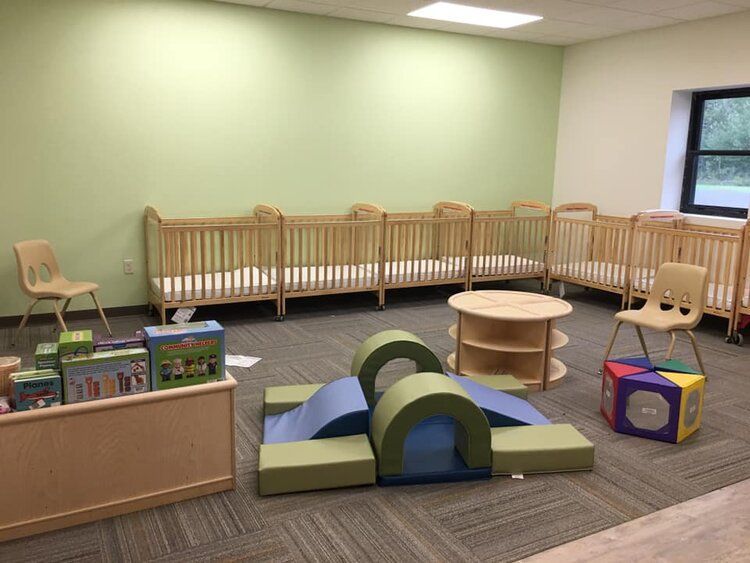The Childcare Dilemma: Quick fixes, and the need for long-term solutions

A room at the Evergrow facility in Ashland, Wisconsin.
Mari Kay-Nabozny
CEO Northwest Wisconsin Workforce Investment Board (NWWIB)
The EverGrow Learning Center has been open for nearly 4 years. Five months after its grand opening, the pandemic struck. However, what has been more detrimental to this childcare facility than the pandemic is an issue plaguing most employers in the nation: finding and retaining workers. We worked to incubate this childcare center, and we knew that staffing was going to be a challenge—but we had no idea just how challenging.
Currently, EverGrow provides care and services to 60 children. To be fully staffed, and serve its maximum capacity of 94 children, it would need to hire 3 additional workers.
The demand for childcare services is omnipresent; however, the staffing resources to be able to accommodate the market need are lacking.
Finding and retaining workers is a major struggle. Low wages and educational requirements often hinder childcare employers from finding workers who are qualified to fill positions. To be a Lead Teacher in a classroom, a person must have the educational equivalent of 6 college credits from courses where the content is applicable to the field of early care and education. The average wage of a childcare worker in Wisconsin is $11.57, compared to the minimum starting wage of $15.00 at Kwik Trip gas stations which require no college education.
Additionally, the perpetual statement that there “is no available childcare” is a paradox. The EverGrow has open spaces at this time for several children. We know from social media and other avenues that other childcare facilities do too. What we are lacking is infant care— for children 2 and under— the most expensive care for a facility to provide, as one caregiver is required for every three to four infants: babies need constant supervision and attention. The ratio of employees to children means that cost recovery for infant care is challenging. The older the child, the easier to recover operating costs. Providing additional infant care slots is a losing proposition for childcare facilities.
When we look at the low wages for the workers, high turnover, and high costs for the families seeking care, we see a vicious cycle. In Wisconsin, the average price of infant and toddler care costs more than in-state tuition or average annual rent. The average price of infant care represents 18.5% of the median family income in Wisconsin and 83.3% of the yearly wages of a minimum wage worker. Wages are too low to attract and retain a consistent workforce, and simultaneously, the cost is too high for the customer base to afford care.
Wisconsin has dedicated several resources to support childcare. Some of these programs have assisted the EverGrow Learning Center in keeping its doors open. Through Federal funding from the American Rescue Plan Act (APRA), the Wisconsin Department of Workforce Development and Department of Children and Families have implemented programs to try to solve the childcare worker and childcare availability problems. Other federal funding through the Quality Jobs, Equity, Strategy, and Training (QUEST) grant that Wisconsin has received is also being used to assist this critical industry. APRA funds to support workforce training have been disbursed through the state’s Workforce Advancement Initiative and QUEST: locally, we have developed programming to train childcare workers and have assisted childcare facilities with the costs of staff through Work Experience and On-the-Job Training.
In addition to addressing the lack of childcare workers, the state through DCF has implemented two unique programs to spur community development of childcare centers and to also pay for the “true cost” of childcare. The Partner Up! Grant program through DCF supports partnerships between businesses who purchase slots at existing regulated child care providers. The funding from this program can be used to increase staff compensation, pay expenses, reserve childcare slots for local business employees, improve the quality of a childcare program, and more. Overall, the program attempts to provide a solution to the true cost of childcare.
With the infusion of funds into the workforce system, the market has in some respects become saturated. However, while we applaud Wisconsin’s efforts to solve this problem, the quick fixes of today are not the long-term solutions needed for the childcare problem. Even with the influx of resources for childcare entrepreneurs, licensing navigators, training funds, free certifications… there is still little demand in accessing them.
Until the industry is elevated as a whole, and wages can be competitive with gas stations, we will not see strides in solving the crisis. For now, our focus is on the future and what will happen once the funding for these cornerstone programs runs its course. To grow local and regional economies, the childcare dilemma needs to be addressed and we remain committed to being a part of the discussion and solutions.
Resources:
https://dcf.wisconsin.gov/childcare/projectgrowth
https://cdn.americanprogress.org/content/uploads/2019/09/12072632/Wisconsin.pdf
https://dcf.wisconsin.gov/files/publications/pdf/5492.pdf
https://www.onetonline.org/link/localwages/39-9011.00?zip=54821


National Association of Workforce Boards | All Rights Reserved |
Created by Olive + Ash.
Managed by Olive Street Design.





